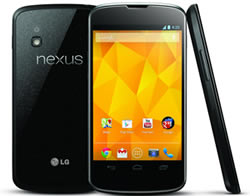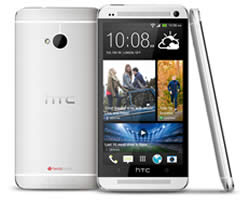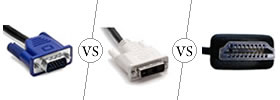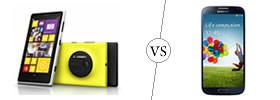Difference between Nexus 4 and HTC One
Key difference: The Nexus 4 is Google's fourth Nexus-branded Android smartphone. It was produced in collaboration with LG Electronics. The phone runs on the Android 4.2 (Jelly Bean) operating system, which was launched with the phone. The HTC One is considered to the successor to the HTC One X. HTC One is expected to be superior compared to the One X in hardware design and software design. The HTC One also features a unique camera implementation.
 With the constant upgrade in technology these days, new models of smartphones as well as upgraded models of smartphones with new features are being constantly launched in the market. Smartphones have become a way of life for many people, allowing them to do anything and everything on the go. This includes typing up a document, chatting with friends, video conferencing, writing up reports, checking e-mails, etc.
With the constant upgrade in technology these days, new models of smartphones as well as upgraded models of smartphones with new features are being constantly launched in the market. Smartphones have become a way of life for many people, allowing them to do anything and everything on the go. This includes typing up a document, chatting with friends, video conferencing, writing up reports, checking e-mails, etc.
One of the most popular operating systems for smartphones and tablets is Android. Android is a Linux-based operating system owned and operated by the Open Handset Alliance, a consortium of 84 leading firms, which includes mobile handset makers, application developers, some mobile carriers and chip makers. The consortium is lead in part by Google, as well as HTC, Sony, Dell, Intel, Motorola, Qualcomm, Texas Instruments, Samsung Electronics, LG Electronics, T-Mobile, Sprint Nextel, Nvidia, and Wind River Systems.
A number of these companies’ smartphones and tablets run on Android. Android is an open source software, which means that the code is freely available for modification and distribution by device manufacturers, wireless carriers and enthusiast developers. Among the number of various companies, Google has also launched its own line of smartphones based on Android, called the Google Nexus. Each device in the Nexus line is produced via collaboration between Google and a leading original equipment manufacturer (OEM) partner.
The Nexus devices in general have an advantage over other devices in that the Android in the Nexus devices is pure. I.e. the Android does not have any manufacturer or wireless carrier modifications to it, such as a custom graphical user interface. The Android also has an unlockable bootloader to allow further development and end-user modification, all of which is usually blocked on other Android smartphones.
The Nexus 4 is Google's fourth Nexus-branded Android smartphone. It was produced in collaboration with LG Electronics. The phone features a 1.5 GHz quad-core Snapdragon S4 Pro processor, 2 GB of RAM, 8 or 16 GB of internal storage, front facing 1.3 megapixel camera and an 8 megapixel rear camera and a micro-SIM card tray. The phone runs on the Android 4.2 (Jelly Bean) operating system, which was launched with the phone. The phone also features a new camera technology, called the Photo Sphere. This allows one to take 360 deg Panorama shots.
An OEM which also had Android based devices in the market is the HTC Corporation. The Taiwan-based company is considered one of the key players in the market of smartphones and tablets. One of its range of popular products are the HTC One Series. These included HTC One X, HTC One X+, HTC One V, etc. Now, the company is launching a new phone, estimated to be released in March 2013, with the name HTC One.
The HTC One is considered to the successor to the HTC One X. HTC One is expected to be superior compared to the One X in hardware design and software design. The HTC One also features a unique camera implementation.
 In terms of hardware, HTC One sports a 4.7 inch Super LCD3, with Full HD1080p, 468 PPI and Corning Gorilla Glass 2. The HTC one comes with Android v4.1.2 Jelly Bean that is upgradable to v4.2.2. The case is an all-aluminum frame with an antenna built into its backing. It includes a 1.7 GHz quad-core Snapdragon 600 processor, Adreno 320 GPU and 2 GB DDR2. The phone is available with non-expandable, 32 or 64GB internal capacity. It offers a 4 megapixel 2688 x 1520 pixels primary camera with autofocus, LED flash and BSI sensor, along with a 2.1 MP, 1080p@30fps, HDR secondary camera. The main feature is the new pixilation system that is opted in the primary camera of the phone, which provides each pixel size of 2.0 µm and sensor size of 1/3'.
In terms of hardware, HTC One sports a 4.7 inch Super LCD3, with Full HD1080p, 468 PPI and Corning Gorilla Glass 2. The HTC one comes with Android v4.1.2 Jelly Bean that is upgradable to v4.2.2. The case is an all-aluminum frame with an antenna built into its backing. It includes a 1.7 GHz quad-core Snapdragon 600 processor, Adreno 320 GPU and 2 GB DDR2. The phone is available with non-expandable, 32 or 64GB internal capacity. It offers a 4 megapixel 2688 x 1520 pixels primary camera with autofocus, LED flash and BSI sensor, along with a 2.1 MP, 1080p@30fps, HDR secondary camera. The main feature is the new pixilation system that is opted in the primary camera of the phone, which provides each pixel size of 2.0 µm and sensor size of 1/3'.
The One also includes a new camera app known as ‘Zoe’, which records a short video alongside every photo taken and allows the resulting photos and videos to be automatically combined and synchronized with music to produce a multimedia presentation known as a Zoe. The One also offers a new feature on the home screen known as the BlinkFeed. This is a newsfeed that automatically upgrades every two hours if connected with a mobile service or more frequently when connected via WiFi. The BlinkFeed takes up the main home screen and cannot be removed, resulting in the people not being able to personally customize the home screen.
The information for the detailed table about the two phones has been taken from the HTC website, the Google Nexus website and GSMArena.com.
|
|
Nexus 4 |
HTC One |
|
Launch Date |
November 13, 2012 |
Expected release March 2013 |
|
Company |
Google; designed in collaboration with and manufactured by LG Electronics. |
HTC Corporation |
|
Size |
133.9 x 68.7 x 9.1 mm (5.27 x 2.70 x 0.36 in) |
137.4 x 68.2 x 9.3mm |
|
Display |
True HD IPS Plus capacitive touchscreen, 16M colors |
4.7 inch Super LCD3 |
|
Screen |
768 x 1280 pixels, 4.7 inches (~318 ppi pixel density) |
1080p, 468 PPI (Full HD) |
|
Protection |
Corning Gorilla Glass 2 |
Corning Gorilla Glass 2 |
|
Weight |
139g (4.90 oz) |
143g |
|
2G Network |
GSM 850 / 900 / 1800 / 1900 |
HSPA/WCDMA: Europe/Asia: 850/900/1900/2100 MHz |
|
3G Network |
HSDPA 850 / 900 / 1700 / 1900 / 2100 |
GSM/GPRS/EDGE: 850/900/1800/1900 MHz |
|
GUI |
Pure Android |
HTC Sense 5 |
|
CPU speed |
Quad-core 1.5 GHz Krait |
Qualcomm® Snapdragon™ 600, quad-core, 1.7GHz |
|
GPU |
Adreno 320 |
Adreno 320 |
|
OS |
Android OS, v4.2 (Jelly Bean), upgradable to v4.2.2 (Jelly Bean) |
Android OS, v4.1.2 (Jelly Bean), upgradable to v4.2.2 (Jelly Bean) |
|
Chipset |
Qualcomm APQ8064 Snapdragon |
Qualcomm APQ8064T Snapdragon 600 |
|
RAM |
2 GB RAM |
2 GB DDR2 |
|
SIM Size |
Micro-SIM |
microSIM |
|
Internal Memory |
8/16 GB storage |
32/64 GB |
|
Expandable Memory |
None |
No |
|
Sensors |
Accelerometer, gyro, proximity, compass, barometer |
Gyro sensor, Accelerometer, Proximity sensor, Ambient light sensor. |
|
Connectivity |
|
|
|
Data |
WiFi, NFC, GPRS, EDGE, USB |
GPRS, EDGE |
|
Speed |
DC-HSDPA, 42 Mbps; HSDPA, 21 Mbps; HSUPA, 5.76 Mbps |
HSPA+; LTE, Cat3, 50 Mbps UL, 100 Mbps DL |
|
WLAN |
Wi-Fi 802.11 a/b/g/n, dual-band, DLNA, Wi-Fi hotspot |
Wi-Fi 802.11 a/ac/b/g/n, Wi-Fi Direct, DLNA, Wi-Fi hotspot |
|
Bluetooth |
Bluetooth v4.0 with A2DP |
Compliant with Bluetooth 4.0, Bluetooth 4.0 with aptX™ enabled |
|
USB |
microUSB (SlimPort) v2.0 |
micro-USB 2.0. |
|
Primary Camera |
8 MP, 3264 x 2448 pixels, autofocus, LED flash |
4 megapixel 2688 x 1520 pixels, autofocus, LED flash BSI sensor, Pixel size 2.0 µm, Sensor size 1/3', Dedicated HTC ImageChip™ 2 F2.0 aperture and 28 mm lens |
|
Secondary Camera |
1.3 MP |
2.1 MP, 1080p@30fps, HDR |
|
Video |
1080p@30fps |
1080p@30fps, HDR, stereo sound rec., video stabilization |
|
Camera Features |
Touch focus, geo-tagging, face detection, photo sphere |
Continuous shooting and VideoPic, Slow motion video recording with variable speed playback, HTC Zoe™ with HTC Zoe™ Highlights and HTC Zoe™ Share Retouch with Object Removal, Group Retouch, and Sequence Shot. |
|
Sound Enhancement |
SNS integration Active noise cancellation with dedicated mic |
HTC BoomSound, Dual frontal stereo speakers with built-in amplifiers, Beats Audio, HDR Microphone and Sense Voice. |
|
Audio supported formats |
MP3/WAV/eAAC+/AC3 player |
Playback: .aac, .amr, .ogg, .m4a, .mid, .mp3, .wav, .wma (Windows Media Audio 9) Recording: .amr |
|
Video supported formats |
MP4/H.264/H.263 player |
Playback: .3gp, .3g2, .mp4, .wmv (Windows Media Video 9), .avi (MP4 ASP and MP3) Recording: .mp4 |
|
Battery Capacity |
Non-removable Li-Po 2100 mAh battery |
2300 mAh |
|
Available Colors |
Black |
Gray, White, Black, with more colors to come. |
|
Messaging |
SMS(threaded view), MMS, Email, Push Mail, IM, RSS |
SMS (threaded view), MMS, Email, Push Email |
|
Browser |
HTML5 |
HTML, Adobe Flash |
|
Radio |
No |
Stereo FM radio with RDS |
|
GPS |
A-GPS support and GLONASS |
A-GPS support |
|
Java |
Java MIDP emulator |
Java MIDP emulator |
|
Additional Features |
|
|
Image Courtesy: blogs.computerworld.com, anandtech.com









Add new comment